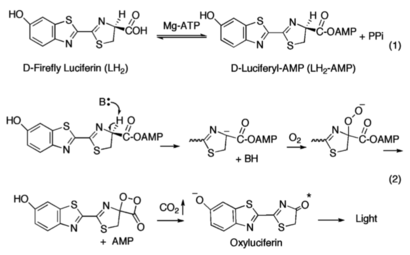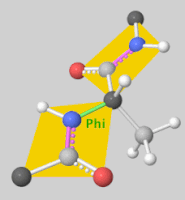Firefly luciferase, of the common eastern firefly (Photinus pyralis), is responsible for the ability of the firefly to exhibit bioluminescence. The enzyme luciferin-4-monoxygenase, which catalyzes a multistep oxidative decarboxylation of the luciferyl-AMP intermediate (LH2-AMP) to produce bioluminescence, is a part of the ANL superfamily named so after the acyl-CoA syntheses, the adenylation domains of the modular non-ribosomal peptide synthetases (NRPs), and luciferase.
Function
![The Common Eastern Firefly in a hand emitting a yellow hue, showing bioluminescence.[1]](/wiki/images/thumb/6/62/Common_Eastern_Firefly.jpg/200px-Common_Eastern_Firefly.jpg)
The Common Eastern Firefly in a hand emitting a yellow hue, showing bioluminescence.
[1]The ANL enzymes catalyze two-step reactions: the first an adenylating step in which an acyl-AMP intermediate is produced; the second step in which the adenylate then serves as a substrate for the multistep oxidative decarboxylation of the luciferyl-AMP (LH2-AMP) intermediate, resulting in bioluminescence.
ANL enzymes follow a domain alternation strategy for the first adenylation reaction, in which the reaction is catalyzed by , and following the formation of the adenylate intermediate and release of pyrophosphate (PPi), the C-terminal domain undergoes a rotational transformation that is necessary for . The [1] of ANL enzymes resides between a 400-500 residue N-terminal domain and a smaller C-terminal domain of ~110-130 amino acids[2]. Ten conserved regions of these proteins have been termed the A1-A10 motifs which play critical roles in either or both partial reactions[3]. Two lysine residues are required for each partial reaction, suggestive that luciferase similarly adopts a rotational transformation for complete catalysis. A mutation of , the A10 lysine, impairs only the initial adenylation reaction[2] whereas mutation of in the A8 region disrupts the oxidative reaction[2].
Biochemical Mechanism of LH2-AMP Oxidation

The generally accepted mechanism of firefly bioluminescence. The first reaction (1) involves the production of an luciferyl-adenylate intermediate. The second reaction (2) involves oxidative decarboxylation that emits CO
2 and results in bioluminescent properties
[2].
The first partial reaction entails the conversion of the carboxyl group of D-luciferin[2][4][5] by luciferase in the presence of ATP and Mg2+, yielding luciferyl-adenylate (LH2-AMP) and pyrophosphate as a by-product. Amino acid residues subsequently are recruited to promote the oxidation of LH2-AMP using molecular oxygen by luciferase (acting as a monooxygenase)[6], which then eventually yields oxyluciferin in the excited-state and CO2. It is upon the return from the excited-state to the ground state that the emittance of a yellow-green light is observed (λ≈560 nm)[5].
An alternative mechanism involving the enantiomer of D-luciferin exists, though typically L-luciferin acts as a competitive inhibitor to the bioluminescence-producing reaction[7], though accounts of light production in small quantities have previously been reported[8]. The mechanism by which L-luciferin acts as the substrate in the presence of luciferase (and ATP and Mg2+) is the same in the first partial reaction, with both producing the intermediate luciferyl-adenylate. Rather than the oxidative decarboxylation step, the adenyl group (AMP) is substituted with CoA-SH yielding luciferyl-CoA. Furthermore, the stereospecificity of luciferase has shown that even in the presence of CoA-SH, D-luciferin was not converted into luciferyl-CoA but proceeded in being used for the emittance of light[5].
Structural highlights
![5'-O-[N-(Dehydroluciferyl)-sulfamoyl] adenosine, shortened to DLSA for brevity. The sulfamate moiety is shown to the far left (sulfur atoms are represented in yellow while oxygen atoms are represented in red). Further, the carbonyl oxygen of the luciferyl-adenylate is connected to the sulfamate moiety via nitrogen atom (represented in blue). [2]](/wiki/images/thumb/6/61/DLSA.png/410px-DLSA.png)
5'-O-[N-(Dehydroluciferyl)-sulfamoyl] adenosine, shortened to DLSA for brevity. The sulfamate moiety is shown to the far left (sulfur atoms are represented in yellow while oxygen atoms are represented in red). Further, the carbonyl oxygen of the luciferyl-adenylate is connected to the sulfamate moiety via nitrogen atom (represented in blue).
[2]
The φ(Phi)/ψ(Psi) angles of the Lys439 residue undergo a rotational transformation of −73°/−12° to −69°/158° in the adenylate-forming to second-catalytic conformation, respectively, showing that the major torsional change in the ψ angle is observed
[2].
The conserved catalytic lysine for the adenylation reaction[9], Lys529, with the carbonyl oxygen of the adenylate, the O5 atom that bridges the ribose and sulfamate moiety, and the main chain carbonyl of Gly316. The second conformation observations show that the of Lys443 adopts a nearly identical position as Lys529, and Gln448 of the C-terminal domain rotates into the binding pocket where it with a sulfamate oxygen[2][4]. Altogether (with the inclusion of an between Glu479 and Arg437), these interactions are responsible for the stabilization of the new C-terminal conformation.
Relevance
![The Common Eastern Firefly expressing bioluminescence seen giving off a yellow-green hue.[3]](/wiki/images/thumb/e/e9/CommonEasternFirefly.jpg/320px-CommonEasternFirefly.jpg)
The Common Eastern Firefly expressing bioluminescence seen giving off a yellow-green hue.
[3]Firefly luciferase has successfully been shown to act as modulatory bioluminescent indicator in the detection and quantification of protein kinase A activation in living cells [10]. Further, due to its bioluminescent sensitivity, firefly luciferase has been utilized in assays as a genetic reporter in eukaryotic cells[11][12][13], amongst other things.
![The Common Eastern Firefly in a hand emitting a yellow hue, showing bioluminescence.[1]](/wiki/images/thumb/6/62/Common_Eastern_Firefly.jpg/200px-Common_Eastern_Firefly.jpg)

![5'-O-[N-(Dehydroluciferyl)-sulfamoyl] adenosine, shortened to DLSA for brevity. The sulfamate moiety is shown to the far left (sulfur atoms are represented in yellow while oxygen atoms are represented in red). Further, the carbonyl oxygen of the luciferyl-adenylate is connected to the sulfamate moiety via nitrogen atom (represented in blue). [2]](/wiki/images/thumb/6/61/DLSA.png/410px-DLSA.png)

![The Common Eastern Firefly expressing bioluminescence seen giving off a yellow-green hue.[3]](/wiki/images/thumb/e/e9/CommonEasternFirefly.jpg/320px-CommonEasternFirefly.jpg)
